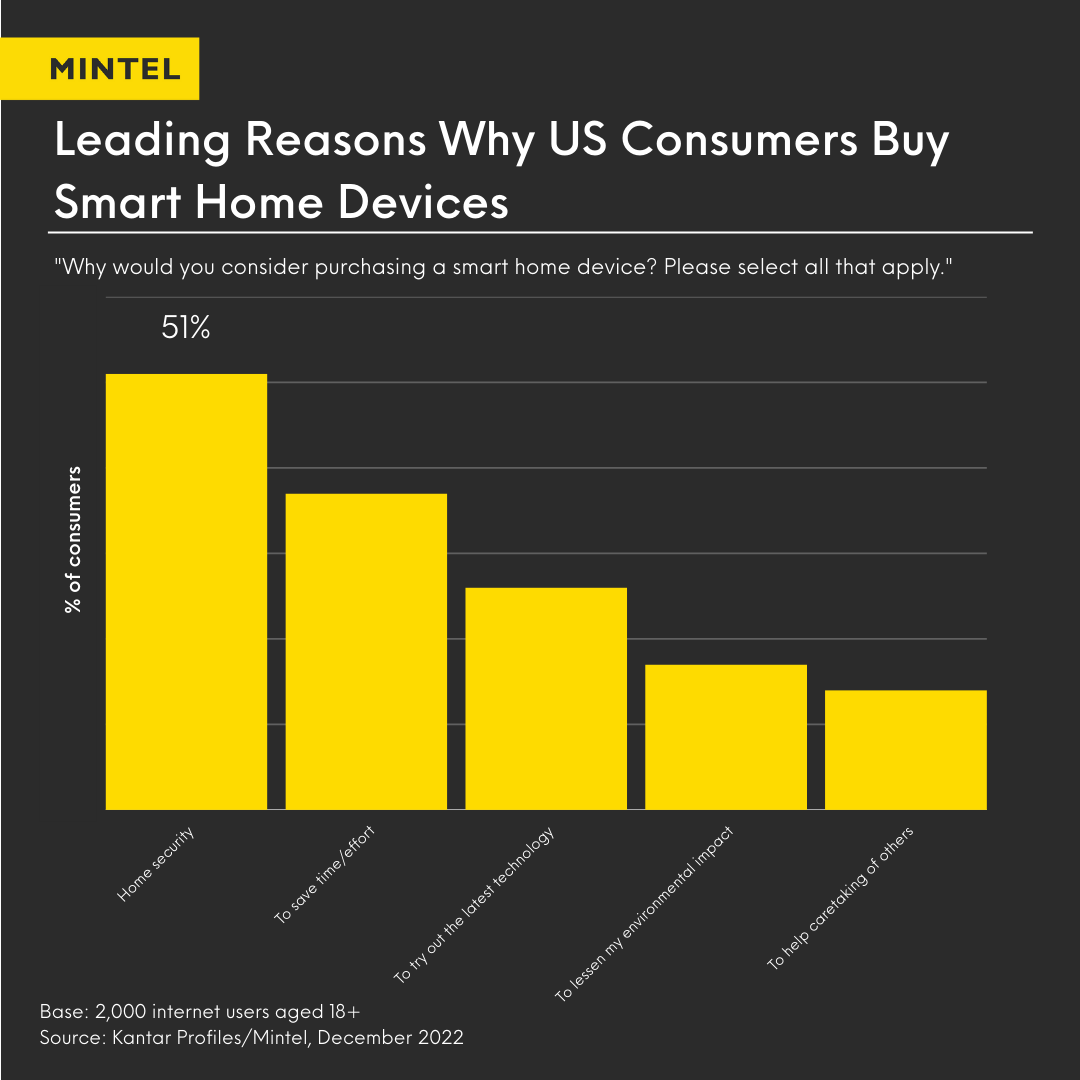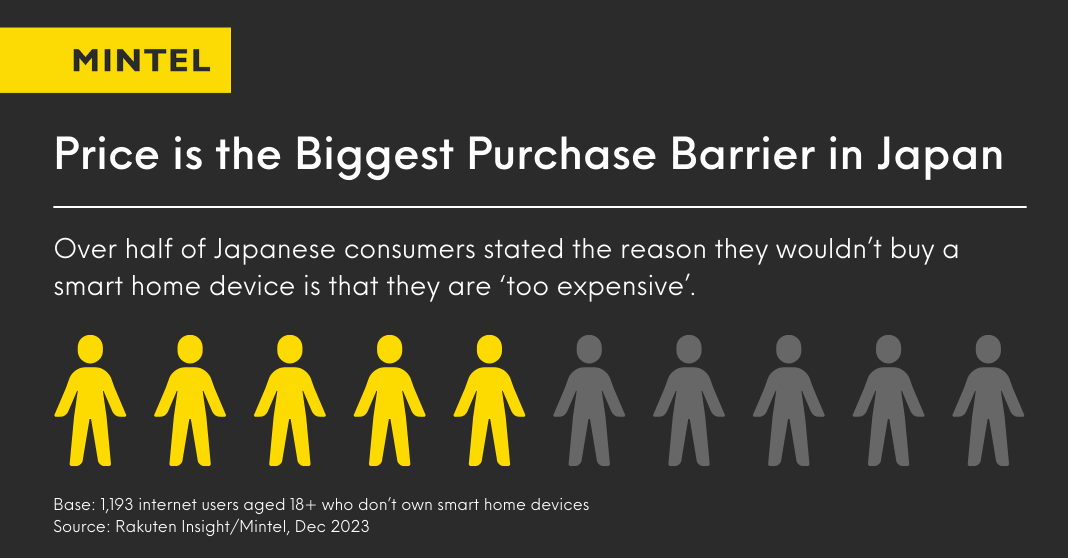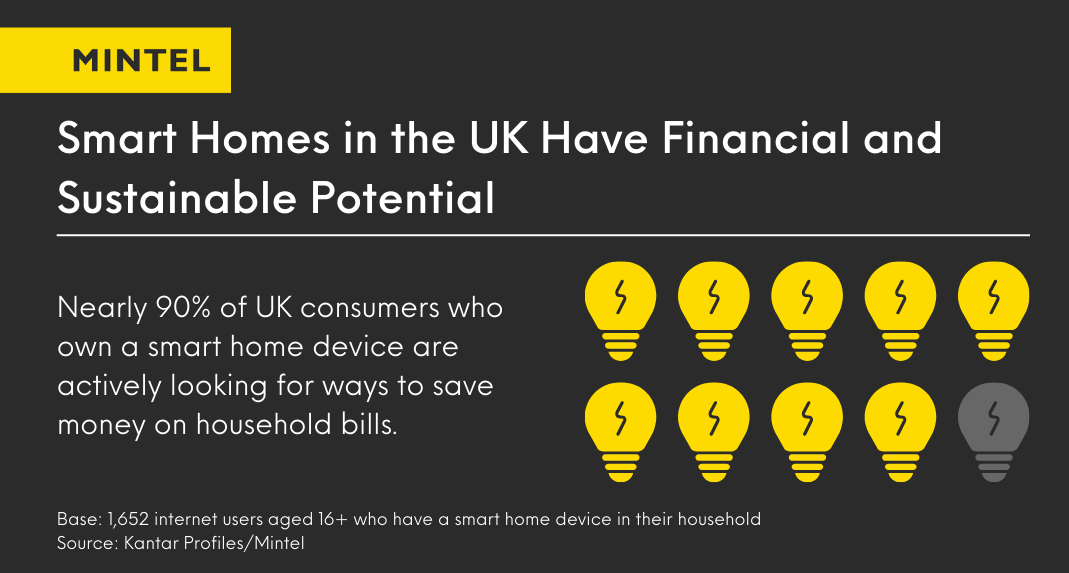Smart home technology is on the rise, transforming houses worldwide and driving a booming global market. Specific markets such as China have had a rapid increase in volume sales from RMB200bn in 2016 to RMB500bn in 2022, with factors such as urbanisation fuelling the demand for home renovations and improvement.
Despite 3 in 4 of Canadian consumer households owning a smart device the market has seen slower growth due to economic uncertainty and inflationary pressures, however, this is predicted to change in the coming years with a rise of connectivity and interoperability features. The UK market has seen growth with 83% of consumers owning some sort of smart home device as of 2023 and is expected to continue to see growth as inflation is predicted to fall and spending power is predicted to rise.
What is Smart Home Technology?
Smart home technology can usually be defined as electronic gadgets that connect within the home, can be controlled remotely via apps or websites, or adapt their functions based on user behaviour.
As the smart home technology market continues to grow, the standard for what qualifies as ‘smart’ has risen rapidly. Today, the expectation is for multiple integrated internet-connected devices to work together seamlessly.
What Do Consumers Want from Smart Home Technology?
Smart technology comes in many forms, offering features that appeal to a wide range of consumers, convenience being the collective force behind its popularity.
The pandemic has undoubtedly played a significant role in the rise of smart homes. After spending extended periods of time inside, consumers have a greater appreciation for what ‘home’ is. Three in five American consumers see making their home comfortable as a priority to them, and eight in ten of British consumers’ think “the home is central to their wellbeing.
In Canada, the established consumer demographic for smart home technology is high-income men within the age category 18-44 but this is changing and innovations are allowing markets to expand to different demographics. There is something in smart homes for everyone. Analysis of purchasing decisions from Mintel’s US Smart Homes Report found that American mums value security and comfort whilst dads are attracted to trying out the latest tech. Children, especially tweens and teens who grasp new technologies quickly, also influence these decisions. According to Mintel’s UK Marketing to Parents Report, children drive change in a family’s purchasing behaviour, often through their social media exposure. Notably, 67% of dads with children under 18 have tried a new product their child has recommended to them.

Barriers to Adopting Smart Home Technology
- Data security: While consumer preferences highlight the growing appeal of smart technology, brands must be aware of barriers to adoption in order to position themselves correctly. There are concerns about data security and privacy. For example, two-thirds of Canadians have data hacking concerns and a quarter of American consumers don’t think their data will be safe, implying that brands need to build trust with consumers to combat this and ensure security is part of the messaging, so consumers know that their data will not be compromised.
- Complexity of technology: Complexity is also a key hurdle in the adoption of smart home technology. In the UK, around two in five consumers using smart home technology find it frustrating to get devices to work together. This barrier is particularly deterring for older consumers. From installation to integration, the whole process can feel overwhelming. Although standards that increase interoperability are on the rise and ready to take over these doubts, brands should still ensure they highlight the value of smart devices and demonstrate that mastering smart home technology is an investment in convenience to combat concerns.
- Cost: Another reason for the reluctance to adopt is cost, which is particularly evident in lower-income households. In the US the top reason why consumers won’t buy a smart home device is cost. Similarly in Japan, over half of consumers claim the high cost of smart home devices is a major barrier to purchase (client access only). In the UK, although the pressure of inflation is weakening, people are still keen on looking for ways to save money, especially due to the energy crisis. In contrast to this, US consumers may start to tolerate higher prices as lower inflation could initiate higher spending on the home. Despite this possibility, Mintel research reports that because over 60% of consumers hope for brands to offer lower cost smart home devices, lower cost brands will appeal to cost conscious consumers.

Innovations in the Smart Home Market
Looking into the future, Mintel analysts reveal that ‘Matter’ will really start to matter. An open-source standard that allows devices from different manufacturers to communicate with each other will greatly assist in eliminating complexity barriers as 61% of Canadians would be interested in exploring different brands if the devices could communicate with each other effectively. According to Mintel’s UK Connected Living and Home Ecosystems Report, at least 170 smart home technology companies are in alliance with Matter including Apple, Google, Amazon and Samsung. Mintel reiterates how essential it is for brands to adopt this program and communicate it to their consumers in order to stay ahead in this highly competitive market.
Furthermore, the rise of AI has been easily embraced by smart homes, unlocking numerous possibilities and opportunities, paving the way for even greater innovation. Recent Mintel reports have outlined expectations for AI implementation in the smart home market in the years 2023-2025 as a quarter of US consumers are looking for devices with AI that learns their preferences and self activates. Smart home technology companies such as Amazon and Apple are looking to use generative AI to update their voice assistance devices to be smarter and enable more natural conversational interactions; investments are being made to develop a feature that allows these assistants to imitate emotional intelligence to enhance the user experience. Although some AI ideas are years away it’s important to recognise them now to anticipate future trends and needs.
Older consumers, such as baby boomers, may be unconvinced by the smart home market, but this will likely soon change. Following the pandemic, consumers have had an increased interest in monitoring their health, and smart homes offer practical solutions to support the older generation and vulnerable individuals living independently. Mintel’s US In-home Lifestyles Report discusses features like automated alerts for maintenance needs and scheduling appointments, which could shape the future of the smart home market for an older demographic. Brands have an opportunity to capitalise now on how automation can add convenience to the older generations’ lives and lean their innovation towards meeting these specific needs.
The smart home market is working towards addressing safety concerns within households, particularly related to intruders and suspicious activity. Innovations like smart sensors and alarms that both detect and prevent threats have emerged, offering effective solutions to enhance home security. Mintel Trends highlights how the brand Ring enhances its smart doorbells with an added layer of security through smart alarms. These alarms automatically activate the doorbell’s cameras when triggered, even in the absence of motion detection. In addition to providing reassurance through advanced safety features, the potential for smart security systems to lower home insurance premiums makes investing in smart home technology an appealing choice for consumers.
Furthermore, biometric security features have become a key innovation in smart home technology, addressing consumers’ desire to safeguard personal information and prevent hacking. The brand Lockly has introduced a smart lock that utilizes facial recognition and a biometric fingerprint scanner, allowing doors to be securely locked with cutting-edge technology.
How Smart Homes Can Help Save the World
Smart home technology has the potential to increase sustainability by increasing energy efficiency through devices such as smart thermostats and smart water meters. This can appeal to a growing eco-conscious demographic, over 2 in 5 Germans think that smart homes have features that address their sustainability goals as they can reduce a household’s environmental impact. Furthermore, this advancement can align energy and cost-saving goals, especially in regions such as the UK experiencing an energy crisis. As the cost of energy rises, consumers are increasingly interested in smart home devices that offer energy management. Mintel’s UK Connected Living and Device Ecosystems Report found that 86% consumers are actively looking to save money on household bills. These consumer priorities present an opportunity for brands targeting the UK to promote energy management and highlight cost savings as a solution that comes with smart home devices. This approach could empower consumers by providing greater visibility over their energy usage, potentially encouraging them to accept higher prices for smart home technology.

What should your brand be doing?
As the world undergoes evolution, so do consumer preferences, giving rise to new trends and opportunities in the smart home market. Consumer research has shown security to be the most attractive factor and price to be the most deterring barrier in adopting smart home devices. Introducing sustainability features in smart home technology such as smart energy monitors will confront cost and conservation concerns consumers may have. Understanding shifts such as the new Matter standard and the implementation of AI in smart homes will serve as an open invitation for businesses to adapt, innovate, and unlock new market potential.
Make sure your brand keeps up with the latest technology market research and expert insights to secure your spot as a forerunner in the smart home technology market.
If you found this article useful, subscribe to Spotlight, our free content platform, for more fresh perspectives and ground breaking insights, delivered straight to your inbox.
24World Media does not take any responsibility of the information you see on this page. The content this page contains is from independent third-party content provider. If you have any concerns regarding the content, please free to write us here: contact@24worldmedia.com

